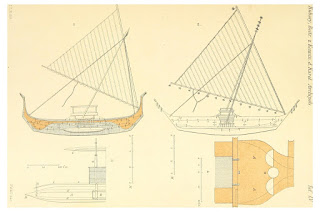| Flying proas of the Caroline Islands, from Adm. Paris. (click any image to enlarge) |
In 1983 and 1984, Steve Thomas, who would later host the television
series This Old House, lived intermittently
on the tiny atoll of Satawal in the central Caroline Islands, an experience he
documented in the book The Last
Navigator: A Young Man, An Ancient Mariner, The Secrets of the Sea. While
there, he lived with and studied under Mau Piailug, a master of the traditional
Micronesian art and science of navigation, who had previously gained notoriety
as the navigator on the early voyages of Hokule’a
(which, as a Polynesian double canoe, was quite a different craft from the
single-outrigger canoes of Micronesia to which he was accustomed).
 |
| A proa from Satawal (From the cover of The Last Navigator, by Steve Thomas) |
Micronesia was home to a great number of outrigger canoe types – so great
that James Hornell, in The Canoes of Polynesia, Fiji, and Micronesia,
devoted many pages documenting separately those of the Carolines, the
Marshalls, the Gilberts, the Marianas, and certain other of the region’s smaller
groups and individual islands. Even within the central Carolines, there was too
much variation between islands for it to be practical to document every differentiating
detail, necessitating some generalization of a “western and central Caroline”
type. Since I came to the subject of the central Carolines canoe by way of The Last Navigator, this post focuses,
to the extent possible, on boats most like those that appear on Satawal, and
relies on Hornell’s generalizations for a more encompassing view.
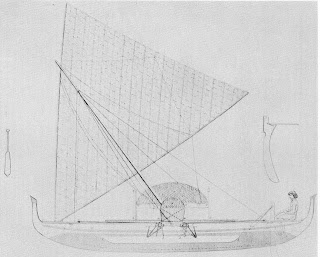 |
| Flying proa or popo of the Caroline Islands. (From Hornell, after Paris) |
Among the most distinctive characteristic of the popo are:
- a narrow, deep hull with identical ends but lateral asymmetry, in which the windward side is much less curved than the leeward. In fact, on some boats, the windward side of the hull is nearly a flat plane.
- hull construction of stitched planks on a dugout base
- a platform extending from the hull on the lee side, opposite the outrigger
- an oceanic lateen rig, consisting of a single triangular sprit sail hung from a mast stepped exactly amidships that pivots fore-and-aft with each shunt, allowing the sail’s direction and its center of effort to shift ends (not, however, without some complex evolutions on the part of the crew)
Hull Form and Construction
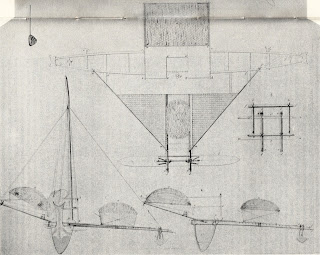 |
| End, plan and section views of the Caroline proa (Hornell, after Paris) |
...all but the upper part of the sides and the two curved heads are hewn from a single log. In atolls where no large timber is available the dugout portion shrinks to a wedge-shaped piece channeled longitudinally on the upper side so as to give two everted edges upon which the garboard strakes are sewn.... Usually the shapes and sizes of the strake planks are irregular, suitable wood being too precious in atolls to permit either of long running lengths or of adzing opposite edges parallel. So the hull in these islands is a mass of patchwork, all, however, fitted together with remarkable accuracy. (Hornell)
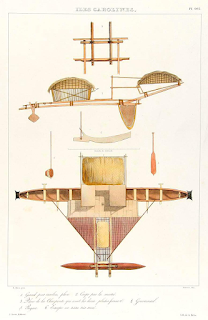 | |
|
Thomas does not describe how planks were split or otherwise gotten out,
but it is clear that adzes were used to shape all the timbers. The hull has two
end pieces cut from solid timber, each of which attaches at an end of the keel
and extends upward as a cutwater and stem “and ends throughout the western and
central Carolines in a peculiar and most characteristic fork” (Hornell).
No plans or standard measuring devices are used in shaping the hull,
the builders working instead by eye and by a series of proportions or ratios
between various of the boat’s features. (For example: height of the mast equals
length of the hull; length of the outrigger is one half the length of the hull.
Thomas.) Regarding the pronounced asymmetry
of the hull, Hornell explains that is counteracts the asymmetrical resistance
imposed by the single outrigger, allowing the boat to travel straight with
minimal steering input when the float is in the water.
Planks are added to the keel to build up the hull’s freeboard with, as Hornell
says, “little or no need to fit strengthening frames and this is not the custom
in the Carolines.... Adequate stiffness is obtained when necessary by the
insertion of solid bulkheads or partitions beneath the transverse supports of
the lee platform.” Stiffness is increased further with heavy thwarts and
gunwales.
Thomas stated that Piailug, in building his new boat, lashed the planks
together temporarily, but Thomas did not explain why. Perhaps it was not enough to ensure that each individual plank fitted properly against its neighbors but that, instead, the entire hull had to be test-assembled to ensure good fits. The wood of the cross-beams (i.e., thwarts) that Piailug wished to install was too tough to
be worked with an adze, so the pieces were buried in moist sand for a period to
soften them.
Planks are stitched to the keel and to each other with discontinuous
stitches of coconut-fiber rope (i.e., coir), made, in Thomas’s account, by the
island’s old men, hand-rolling the coconut fibers against their thighs. Planks
were caulked with a compound of dehydrated breadfruit sap applied to strips of
coconut husk. According to Thomas, this caulking gradually dries out and loses
its efficacy, requiring the boats to be disassembled and rebuilt “every two
years or so.”
During one of these rebuilding episodes on Satawal on a boat named Suntory (after a brand of Japanese
whiskey), the builder in charge decided to lighten the boat to make it faster.
After disassembly, all the planks were therefore adzed down to make them
thinner. Thomas did not describe whether this process improved the boat’s
performance or affected its strength or water-tightness.
Thomas agrees with Hornell in saying that the outer surface of the hull
was finished very smooth, although the process of sanding or otherwise
smoothing the planks it is not described by either. (Throughout much of the Pacific, shark skin was used as sandpaper for this purpose.) Hulls were traditionally painted in patterns of red,
black, and white.
Outrigger and Lee Platform
According to Hornell, the two main outrigger booms, which are fairly
straight, “pierce both washstrakes of the hull in large canoes and (extend) a
few inches outboard on the lee side.” (In Hornell's version of Admiral Paris’s drawing, however, it
is unclear if the booms are entirely surrounded by the washstrake or if,
possibly, they are notched full-depth into its top surface). In the popo’s most characteristic form, the outrigger booms also serve as the main
support for a large triangular platform which carries crew and cargo. Poles
extend diagonally from the windward gunwale at points near both ends of the
hull to the main booms near their outboard ends, and the resulting isosceles
triangle is covered by planks or light poles.
A second rectangular platform extending from the hull’s leeward size further increases the boat’s cargo capacity. This platform is
supported by another pair of heavy timbers that cross the hull. These timbers
are angled sharply upward toward their outboard end, allowing the platform to
remain dry with the boat at a significant angle of heel. Sometimes the surface
of the platform is built directly on these sloping supports; on other
cases, another, lighter framework is built over this main structure and decked
over, creating a surface that is horizontal when the boat is on an even keel.
Enclosures of basketwork, which may be round, oval, or rectangular,
often appear on one or both platforms. These are used primarily to protect
cargo, but it appears they occasionally serve as shelters for passengers or
off-duty crew.
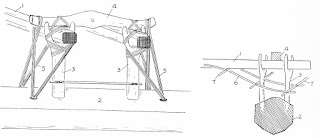 |
| Connection between the outrigger booms and the float. In the image on the left, the inner two crutches have been omitted for clarity. (Hornell) |
Sail Rig and Steering
| Caroline proas (Paris) |
Hornell takes pains to define the nomenclature of the sail’s spars,
calling the one at the luff (the upper/forward edge) a yard, and the one at the
foot a boom. He describes the rigging as follows:
A shroud runs from near the masthead to the yoke [i.e., the short, stout timber connecting the outrigger booms at their outer ends], to which it is secured after passing through a hole bored through its center. There is also a fore-and-aft running stay made fast respectively to the endmost thwart at each end of the hull.
(T)he sail is hoisted by a peak halyard attached far out on the yard and rove through a sheave hole in the masthead; the heel of the yard rests against a sail step set on a short thwart right in the bows, to which the tack is made fast.
There is no shroud or other line serving as such to leeward in this
description, and in Thomas’s account of a voyage from Satawal to a nearby
atoll, the rig was nearly lost once when the sail was backwinded, due to this
lack of support on that side of the boat. No leeward shroud is shown in the diagram
or cover photo of Thomas’s book, but in Paris’s diagram and one of his drawings (fifth and first images in this post),
a shroud is visible leading from the masthead to the lee platform. Perhaps the
practice varied on different islands even within the central Carolines.
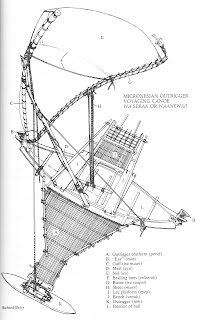 |
| Main features of a Satawal proa (from Thomas) |
Canoe Houses
Experienced men of middle age do most of the work on the canoes,
assisted and observed by younger ones -- or, in Thomas's account, those few younger ones who could be induced to take an interest any longer. Older men typically observe the work and
offer suggestions but restrict their hands-on contribution to the making of
rope.
Primary Sources:
Hornell, James, The Canoes
of Polynesia, Fiji, and Micronesia, B.P. Bishop Museum, 1936, in Canoes
of Oceania (with A.C. Haddon), B.P Bishop Museum, Honolulu, 1975
Kubary, J.S., Ethnographiphische Beiträge zur Kenntniss
des Karolinen-Achipel, Leiden, 1889-95
Pâris, François-Edmond, Essai sur la construction navale des peuples
extra-européens ou Collection des navires et pirogues construits par les
habitants de l'Asie, de la Malaisie, du Grand Océan et de l'Amérique dessinés
et mesurés pendant les voyages autour du monde de "l'Astrolabe",
"la Favorite" et "l'Artémise")
Additional sources, useful websites and pages:
http://www.samlow.com/screeningroom/navigators-filming.html
http://starrigging.blogspot.com/ and http://starrigging.blogspot.com/2017/06/canoe-sketch.html
http://waterworks-sysooke.blogspot.com/2011/10/chamorro-and-carolinian-sailing-canoes.html
http://archives.starbulletin.com/2008/04/25/features/story04.html
http://www.multihull.de/proa/history/p_history.htm
http://habele.blogspot.com/2017/03/historic-sail-showcases-micronesian.html
http://www.samlow.com/sail-nav/CEREMONY.htm
http://proafile.com/multihull-boats/article/the-proa-file-primer
